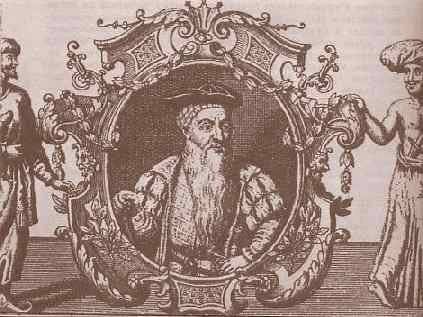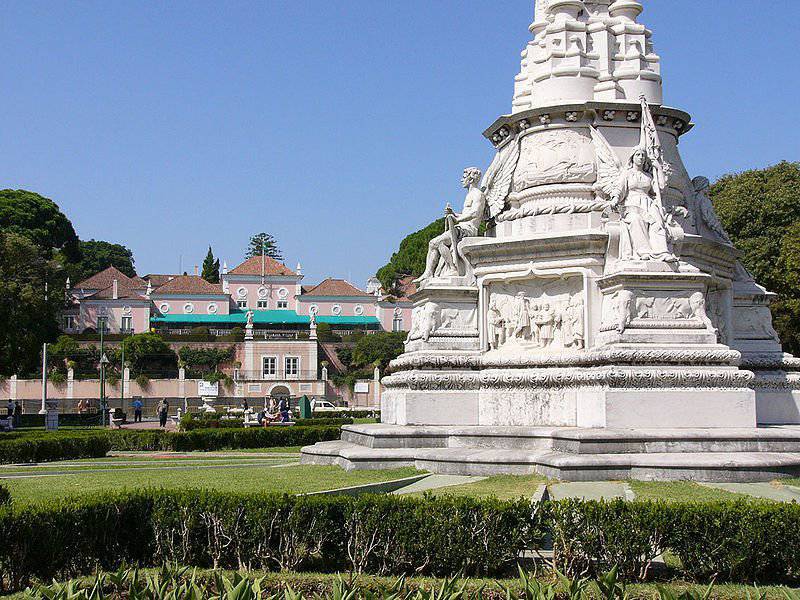Afonso de Albuquerque - the great Portuguese navigator and conqueror
 XV century. The centuries-old trade in Europe and the East was interrupted by the powerful Ottoman Empire. Europeans are beginning to search for the sea route to the country of fabulous wealth - semi-mythical India.
XV century. The centuries-old trade in Europe and the East was interrupted by the powerful Ottoman Empire. Europeans are beginning to search for the sea route to the country of fabulous wealth - semi-mythical India. In 1499, the Vasco de Gama expedition arrives in Lisbon with the news that a route bypassing the west coast of Africa has been found. The fleet headed by Cabral was immediately equipped. His task was to gain a foothold on the shores of India and to establish trade and diplomatic relations with local authorities.
Afonso de Albuquerque - in the near future, the inspirer and architect of Portuguese rule in India - at that time served in the rank of Chief Stable at the court of the king. The title was granted for service in the wars against the Muslims of North Africa, during which the Moroccan cities of Tangier and Asila were taken. The genealogy of young Albuquerque also played a significant role in conferring an honorary title. He is the second son of Senor Vila Verdi, born in 1453 year. Father’s grandfather, and Afonso’s father himself, served as trusted secretaries to the kings Duarte I and João I. Mother’s grandfather was a Portuguese admiral. He was ensured a career without military exploits. But the tradition of military service and personal ambitions led Afonso to start his military career in 1471.
In 1504, Albuquerque, along with cousin Francisco de Almeida, arrives in India and, despite opposition from Arabs, who were not happy about the emergence of new competitors, strengthened their relations with the local Raj Cochin. The union was strengthened by the efforts of the Portuguese and the first Portuguese outpost, as well as the Kulan trading post, appeared on the west coast of Hindustan. In July 1504, the royal court in Lisbon from Albuquerque himself learned about the success of the mission. The rest of the year a plan was developed to disrupt Arab trade in the region and support the newly acquired allies in the Indian Ocean. Albuquerque played an important role in the development of plans and the main one in their implementation.
In August 1506, the fleet of Tristana de Cugnio of 16 ships was sent to implement these plans, Albuquerque entrusted with the command of five ships. The expedition along the eastern coast of Africa was predatory and terrifying. After a series of successful raids, the Albuquerque squadron separated from the main fleet and continued raids on Arab settlements.
However, Albuquerque understood that Arab plunder could not be undermined by simple robbery, and in August 1507 he landed on the island of Socotra at the entrance to the Red Sea. The fort founded there owing to the strategic position of the island was to create serious problems for Arab trade. The next step was to seize the island of Hormuz, which controls the entrance to the Persian Gulf. Trade with Europe belonged to the one who owned this strait.
This time the Portuguese failed to gain a foothold on the island. The captains of the ships were not in the mood for the strategic interests of the Portuguese crown, when fabulously rich India was lying very close ... Albuquerque was left with only two ships, which did not prevent him from continuing the shelling of Arab and Persian coastal settlements. In the future, the Portuguese crown fully approved the actions of the admiral.
The third and last expedition to Afonso de Albuquerque to India took place in 1508. In December, he reported to Almeida about his new appointment as the viceroy of India, for which he was put under arrest, from where he was released only after the arrival of the Grand Marshal of Portugal. Paradoxically, sources say that Almeida rudely disobeyed the order of the king out of a thirst for revenge on the Calcutta people, in the battles with which his son died. In November, 1509 was either due to the marshal, or to the fact that Francisca considered his son revenge - Afonso, nicknamed the Great Albuquerque, took the post of viceroy of India. Afonso immediately continued the already tested strategy of building outposts on the coast. But failed to gain a foothold even in Cochin. Then it was decided to seize the rebuilt and fortified Muslim harbor. For this purpose, the newly minted Viceroy of India was able to negotiate support with local corsairs and assemble a fleet in the 23 ship. In March 1510, the Portuguese seized the fortress of Goa, however, kept it for only two months, but in May, cutting out defenders, again returned. The mastery of Goa played an extremely important political role. Indian rajas could no longer ignore the Europeans and were forced to reckon with a new force in the region.
Goa became the capital of the Portuguese crown in the region and a springboard for penetrating deep into the peninsula. Albuquerque sought to ensure that the trade of Persia and India (mostly horses) went through Goa, and at the same time the port should not bypass the ships with spices from the Indonesian archipelago. For complete control over the Indian Ocean trade, a bridgehead was needed near the spice island. They are rightly considered the city of Malacca.
In 1511, the 15 ships of the Portuguese, on which there were about 1600 soldiers, approached the city. Some sources report that there were about 100 thousand defenders in the city, commanded by the captain and Gujarat, who had experience in fighting against the Portuguese, although the estimate of the forces seemed somewhat overestimated. One way or another, the Portuguese seized the key point of the spice trade. The construction of powerful fortifications began immediately on the island, which will last for about 130 years.
At this time, taking advantage of the absence of Albuquerque, Adil Khan, at the head of the 60-thousandth army, besieged Goa and captures the city of Benastarin. However, this army was also defeated, thanks to the reinforcements that arrived in time from Portugal.
Further actions were aimed at undermining Arab trade in the Persian Gulf and the Red Sea. The outpost on the island of Socort did not justify itself, and the capture of Aden, the closest city on the Arabian coast, required resources that the Portuguese did not possess. However, having replenished the troops with Indian volunteers, he attempted to capture Albuquerque after all. It turned out, of course, unsuccessful.
Then the shores of Abyssinia were explored, where nothing of particular value to the Portuguese was found. On his return from Abyssinia, Albuquerque inflicts a crushing defeat on the state of Calicut, thus ending the war with the Aborigines. After this victory, peace reigned for a while.
In February, 1515, Admiral Afonso de Albuquerque, already a duke, resumed active efforts to establish Portuguese supremacy in the Indian Ocean. With a flotilla of 15 ships, Albuquerque for the second time landed on the island of Hormuz, the garrison of which surrendered without a fight. Fortifications were built on the island, which belonged to the Portuguese crown before 1622. After the capture of Ormuz, even plans to seize Bahrain were hatched, but they were not destined to come true. In September 1515, the viceroy of India became seriously ill and was sent to Goa. On the way, it was reported that the king removed Albuquerque from his post and transferred all the affairs of Lopi to Suarish - personal enemy Afonso. The latter, in indignation, wrote a letter in which he assured the monarch of disinterested loyalty and asked to take care of his illegitimate son. The king received a letter after the death of Afonso de Albuquerque, but was so moved that he allowed the bastard to bear the full name of his father, as well as the title of duke, which was rare.
The merits of Afonso de Albuquerque are not limited to successful military enterprises. It was his captains who first reached the shores of China and stood in the bay of the Pearl River. He was the first to equip and lead expeditions to the Malabar Islands, the island of Ceylon, and to Southeast Asia. As the viceroy of India, he displayed brilliant administrative and managerial skills, turning Goa into a thriving commercial city. Through the efforts of the tireless Portuguese, the first in stories New time colonial empire.
Among the Arabs there were legends about this man. He seemed a mythical "crusader" for whom nothing is impossible. Some said that he plans to turn the bed of the Nile to flood Egypt and thereby conquer it, others that he is going to steal the Kaaba from Mecca and use it to liberate the Holy Land from Muslims.

Afonso de Albuquerque is buried in Goa. Subsequently, his son, Brush Afonso, will publish part of his father’s work entitled “Comments by Great Afonso de Albuquerque” and build the famous “Faceted House” in Lisbon.
The story is relentless, and the first colonial empires - Portugal and Spain - will be forced out by the rapidly gaining power of England and Holland. But thanks to Afonso de Albuquerque, trade with the East was in the hands of Portugal for almost a century and a half.
Based on materials:
http://vivovoco.rsl.ru/VV/PAPERS/HISTORY/ALBU.HTM
http://www.abhoc.com/arc_vr/2010_09/579/
http://territa.ru/publ/4-1-0-31
http://ru.wikipedia.org/wiki/%D0%90%D0%BB%D0%B1%D1%83%D0%BA%D0%B5%D1%80%D0%BA%D0%B8,_%D0%90%D1%84%D0%BE%D0%BD%D1%81%D1%83_%D0%B4%D0%B5
Information